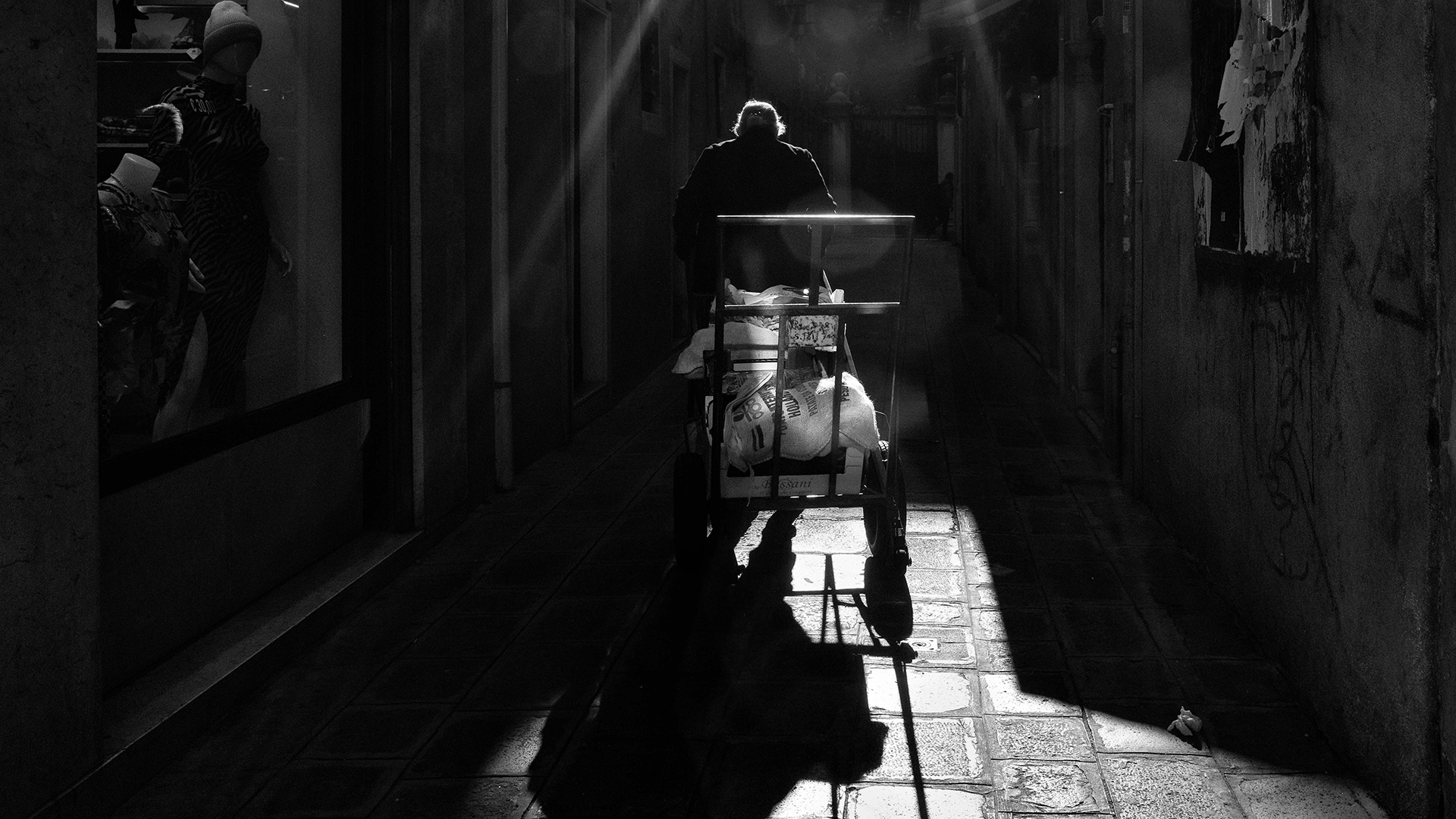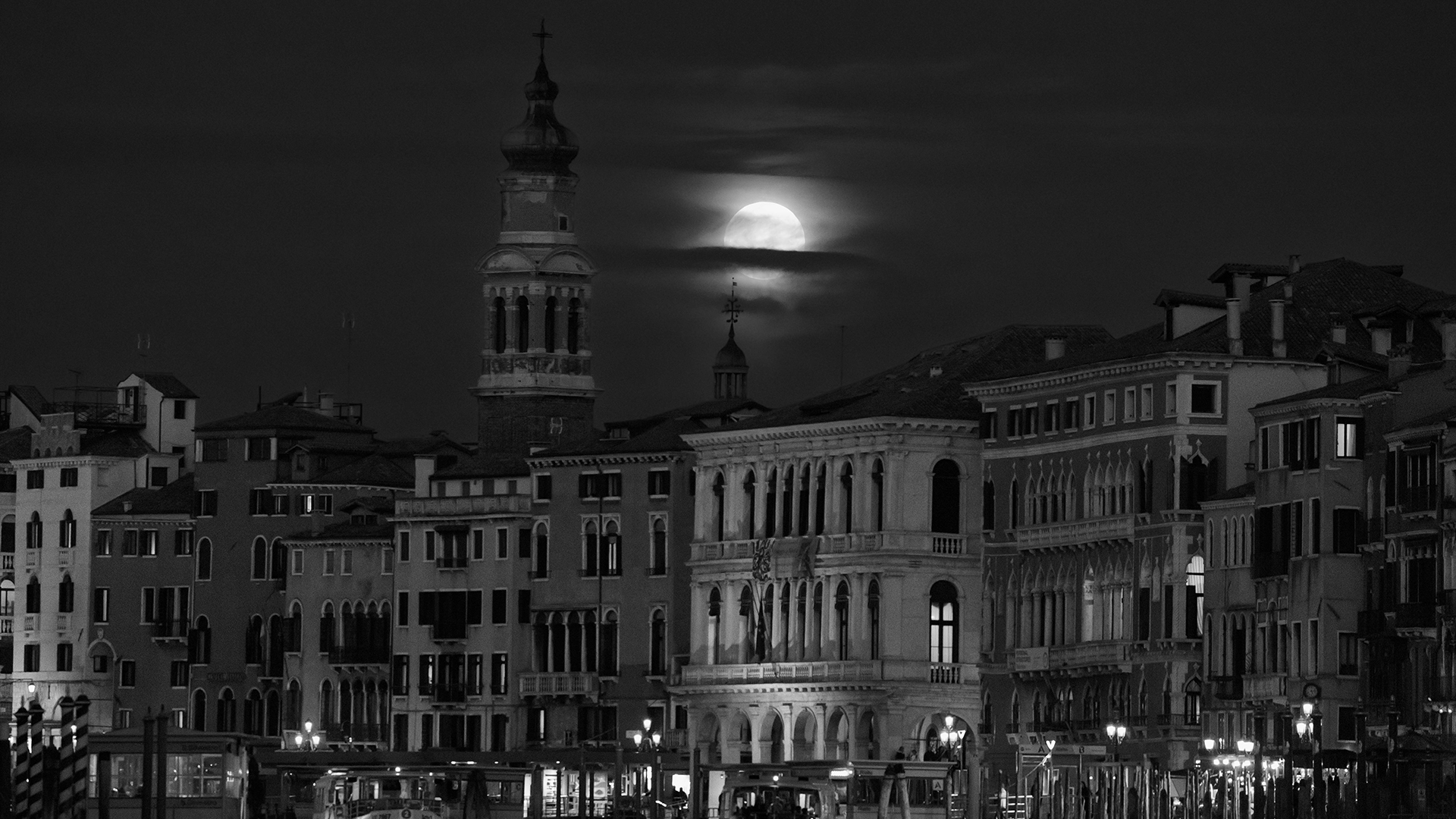

The Fondazione dell’Albero d’Oro exhibits images of the inhabitants of Venice, to tell the stories of those who live in the city and bring to life the places that represent it in the world.
Journalist and anchor-man of international renown, Nikos Aliagas (Paris, 1969), French of Greek origin, is also a self-taught photographer, whose gaze gives a vision of the world full of humanity he highlights through the contrasts of black and white. Empathetic with the subjects he photographs, close to the artistic sensibility of Salgado, Koudelka or Artikos, Nikos Aliagas tries to capture the essence of people, the mystery of their existence. His “pilgrimage of observation” led him to immortalize Venice as a city full of humanity, secrets and distant echoes. Nikos Aliagas walked through Venetian streets to meet people you don’t usually see in the city: its inhabitants, the persons who avoid the gazes of tourists’ cameras. His Regards Vénitiens project, which is now an exhibition, took shape and developed in his soul when he was invited from Fondazione dell’Albero d’Oro to spend some months in Venice from July to December 2022. This was his first time in the Lagoon and here he could observe its mysterious and charming essence. He soon realized that he wanted to look inside Venice, exploring the world of Palazzo Vendramin Grimani, immersing himself in the extraordinary everyday life of Campo San Polo to tell the stories of the persons living in this place. The result of his work is a series of original works created specifically for the exhibition Nikos Aliagas. Regards Vénitiens, set up on the ground floor and in the courtyard of Palazzo Vendramin Grimani – over 400 square meters – from February 4 to April 2.
When you first arrived in Venice, what did you feel and how did you find the basis for the development of your project Regards Vénitiens?
When we talk about Venice it is always difficult to speak of a first time, as it is a city that sees so many tourists, tens of millions every year. So when you say “arriving for the first time” it’s like you are arriving very quietly in a place that is stronger than you, bigger than you. A place that has been seen, photographed, drawn and that has inspired the entire planet through the centuries. So you get there very humbly. And of course it was impossible during my stay and my round trips to say that I would come to present an exhibition concerning the whole city of Venice: in Venice you have to choose. Otherwise you are lost. Even if the very interesting thing the first time I came here was just getting lost in the streets of the city, and then being able to find myself somehow or find, maybe, what gave me a strange feeling of being observed. I felt like Venice was watching me. The starting point was the San Polo district, where the first inhabitants of the city had settled, because it was an area safe from sea flooding. San Polo is a small district but also one of the oldest. And this microcosm really moved me. It was there that I saw the true inhabitants of Venice, those I was interested in, namely the bartender, the cake shop lady, the shoemaker, the look of a man who smokes quietly on a balcony while looking at the world passing by. I found this very interesting because after all you can be Venetian and have seen the world without having travelled. And it is precisely this look that I wanted to photograph. A look that knows, that remembers and at the same time does not judge. A look that observes the world moving and in this city where everything is movement – with millions of people walking incessantly up and down bridges – it is exactly in stillness that its meaning is best grasped. Or rather in a false stillness.
You were able to get very quickly into the heart of the city, capturing its innermost aspects. What are the results of your visual reportage? How do you see the future of Venice?
A photographer never really knows if he has achieved the result he had meant to. I can make an appointment with someone to take pictures, but what interests me is what I don’t know. For instance you visit a mask workshop only to realize that a corner nearby tells you more about the place than the workshop itself; or while strolling through the streets you come across young people, Italians and Venetians, making paper prints as their grandparents or great-grandparents used to do more than 100 years ago. It is a city that can surprise you at any time. It is a city of details and micro-details at the same time and a city of horizons as well. The continuous movement coming from water can sometimes give you a strange feeling, but at the same time it creates a balance. You get the feeling that Venice lives suspended between past, present and future with a question mark. I do not have an in-depth knowledge of all the problems related to the future of Venice to be able to talk about it advisedly but one thing is clear to me: since its creation, everyone has wondered if it would survive. Those who have asked themselves this question and who still ask it today to have the answer before their eyes. Venice is still here. Venice is at the same time an idea and a great architectural work. It is something both visible and invisible. A sentence I love to hear says: “I have decided to change my life, I’m moving to Venice. I quit everything and go to live in Venice”. As if Venice gave you the right to be reborn. It’s exactly what I felt myself when I first came to this city. As if you could be baptized again in the waters of Venice and start a new life.

Venice, one of the most photographed and represented cities in the world. Can it still surprise us?
In Venice the sky is never the same. You can photograph the Rialto Bridge a million times, it will never be the same bridge. The light here is fantastic. You can visit churches such as Santa Maria Gloriosa dei Frari, the Scuola Grande di San Rocco, or the palaces… It takes several lifetimes to understand Venice. Although “understand” is probably not the right term to use here, because it is a verb that includes the idea of “grasp”. I didn’t come to Venice to grasp something. I did come to leave something, namely my gaze. And when I left, I kept inside myself its silence, its chiaroscuro, its lights. Like something precious and fragile. I would therefore say that it is a city that may surprise you as long as you do not get here full of certainties.
You chose to tell your visual story exclusively in black and white. What are the reasons for this choice?
I chose black and white for my pictures because I think it is the best choice to capture only the essential: the curve, the contrast and the shot. I may be wrong, but my first photographic emotions were in black and white: the pictures of my ancestors that I discovered when I was young, in a shoebox belonging to my grandmother, in Greece. I spent the rest of my life until today that I’m 54, looking for that first emotion, those timeless faces almost fixed in a drama, in something written and engraved on the marble of time. At that time people did not use to smile in pictures, because they considered photography as a serious act, a signature and not a hobby. Maybe that’s what I’m still looking for by choosing black and white: timelessness and at the same time a signature. A signature against the misunderstanding of color. It is much easier to take a picture of a beautiful sunset than of an old man smoking in a narrow street in Venice, an old man who has not posed to be photographed and who has much more to say than a postcard.
What new suggestions did your staying at the Fondazione dell’Albero d’Oro offer to your artistic career?
This residence is a work of art. The Palace is a work of art. When you arrive here with your photos and your gaze on the city you have to tell very modestly your feelings about Venice and at the same time marry the atmosphere of Palazzo Vendramin Grimani. At first this is not so simple, because the Palace is still stronger than you. Palazzo Vendramin Grimani has been there for six centuries and you arrive with your photographs and you inevitably feel small! You simply don’t exist. And what’s more, you say to him: “Look what I’ve seen of you.” You must be a little crazy to offer a mirror to a Venetian. “Look in the mirror.” I do not know if I managed to convince him, but that this was not my goal; my goal was to bring our eyes together. And I believe that the Foundation, especially Béatrice de Reyniès and all her staff have allowed me to tell everything I have seen and experienced inside me during this journey which I will always consider as an initiatory journey. We can still be moved, we can still find ourselves, get lost in a city that we think we know even from afar. Conclusion: you have to come to Venice to go back to Venice.
